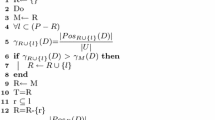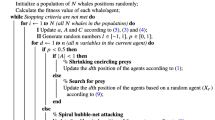Abstract
Feature selection (FS) is defined as the process of selecting a criterion function for evaluating a feature subset and a search strategy for finding the best feature subset from a large number of feature subsets. Many strategies have been established to date, most of which are based on statistical theory; nevertheless, research is currently ongoing to find better solutions in terms of optimality and computing ease. In FS, where most other methods require supplemental knowledge, the rough set ideology of using only the available data and no further information offers several advantages. The key drawback is that the rough set-based feature selection does not function well on data that are real-valued or noisy (continuous datasets). To overcome this problem, we propose three algorithms based on particle swarm optimization with fuzzy rough fitness function for getting optimal feature subset from a feature set with a large number of features (i.e. continuous or discrete datasets). The suggested algorithms are compared against two classical feature selection methods, as well as three PSO and rough set-based feature selection approaches. Seven commonly used discrete datasets with a modest number of features and eight continuous datasets with a large number of features were utilized in the experiments. Two classification techniques (decision tree or DT and Naive Bays or NB) are used to evaluate the classification performance of selected feature subsets. The results show that using the proposed techniques, a small feature subset may be automatically selected with better classification accuracy than utilizing all features. In terms of classification accuracy and amount of features, the suggested algorithms beat the two traditional and three PSO and rough sets-based feature selection approaches. There is also a significant reduction in the number of features with higher weight on the rapid reduct of the fitness function, as well as improved classification accuracy.


Similar content being viewed by others
References
Al-Ani A (2005) Feature subset selection using ant colony optimization. Int J Comput Intell 2:53–58
Almuallim H, Dietterich TG (1994) Learning Boolean concepts in the presence of many irrelevant features. Art Intell 69(1–2):279
Bache K, Lichman M (2013) UCI machine learning repository
Bae C, Yeh WC, Chung YY, Liu SL (2010) Feature selection with intelligent dynamic swarm and rough set. Exp Syst Appl 37(10):7026
Barani F, Mirhosseini M, Nezamabadi-pour H (2017) Application of binary quantum-inspired gravitational search algorithm in feature subset selection. Appl Intell pp 1–15
Beaubouef T, Petry FE, Arora G (1999) Rough fuzzy hybridization: a new trend in decision-making. Springer, Singapore pp 200–214
Cervante L, Xue Shang BL, Zhang M (2013) In European conference on evolutionary computation in combinatorial optimization. Springer, pp 25–36
Cervante L, Xue B, Shang L, Zhang M (2012) Australasian joint conference on artificial intelligence. Springer, pp 313–325
Chakraborty B (2002) In: IEEE International symposium on industrial electronics (ISIE’02), vol 1, pp 315–319
Chakraborty B (2008) In: 3rd International conference on intelligent system and knowledge engineering. ISKE 2008, vol 1 (IEEE, 2008), pp 1038–1042
Chen Y, Miao D, Wang R (2010) A rough set approach to feature selection based on ant colony optimization. Pattern Recogn Lett 31(3):226
Clerc M (2012) https://hal.archives-ouvertes.fr/hal-00764996
Cornelis C, Jensen R, Hurtado G, Śle D et al (2010) Attribute selection with fuzzy decision reducts. Inf Sci 180(2):209
Dash M, Liu H (1997) Feature selection for classification. Intell Data Anal 1(3):131
Dubois D, Prade H (1992) Putting rough sets and fuzzy sets together. Intelligent Decision Support. Springer, pp 203–232
Guyon I, Elisseeff A (2003) An introduction to variable and feature selection. J Mach Learn Res 3:1157
Hall MA (1999) Correlation-based feature selection for machine learning. Ph.D. thesis, The University of Waikato
Höhle U (1988) Fuzzy sets and systems. Math Fuzzin 27(1):31
Huang CL, Dun JF (2008) A distributed PSO-SVM hybrid system with feature selection and parameter optimization. Appl Soft Comput 8(4):1381
Huda RK, Banka H (2020) New efficient initialization and updating mechanisms in PSO for feature selection and classification. Neural Comput Appl, pp 1–12
Huda RK, Banka H (2019) Efficient feature selection and classification algorithm based on PSO and rough sets. Neural Comput Appl 31(8):4287
Jensen R (2006) Swarm intelligence in data mining. Springer, pp 45–73
Jensen R, Cornelis C (2010)IEEE international conference on fuzzy systems (FUZZ-IEEE), 2010, pp 1–7
Jeong YW, Park JB, Jang SH, Lee KY (2010) A new quantum-inspired binary PSO: application to unit commitment problems for power systems. IEEE Trans Power Syst 25(3):1486
Ji B, Yuan X, Chen Z, Tian H (2014) Improved gravitational search algorithm for unit commitment considering uncertainty of wind power. Energy 67:52
Kohavi R, John GH (1997) Wrappers for feature subset selection. Art Intell 97(1):273
Kudo M, Sklansky J (2000) Comparison of algorithms that select features for pattern classifiers. Pattern Recogn 33(1):25–44
Liu H, Setiono R (1998) Incremental feature selection. Appl Intell 9(3):217
Liu Y, Wang G, Chen H, Dong H, Zhu X, Wang S (2011) An improved particle swarm optimization for feature selection. J Bionic Eng 8(2):191–200
Marill T, Green D (1963) On the effectiveness of receptors in recognition systems. IEEE Trans Inf Theory 9(1):11
Muni DP, Pal NR, Das J (2006) Genetic programming for simultaneous feature selection and classifier design. IEEE Trans Syst Man Cybern B Cybern 36(1):106
Neshatian K, Zhang M(2009) Proceedings of the 11th annual conference on genetic and evolutionary computation. ACM, pp 1027–1034
Pawlak Z (2012) Rough sets: theoretical aspects of reasoning about data, vol 9, Springer Science & Business Media
Pawlak Z (1982) Rough sets. Int J Comput Inf Sci 11(5):341
Pawlak Z, et al (1991) Dordrecht & Boston: Kluwer Academic Publishers
Pawlak Z, Skowron A (2007) Rudiments of rough sets. Inf Sci 177(1):3
Pedrycz W (1999) Rough fuzzy hybridization. A new trend in decision-making, pp 179–199
Rodrigues D, Pereira LA, Almeida T, Papa JP, Souza A, Ramos CC, Yang XS (2013) 2013 IEEE international symposium on circuits and systems (ISCAS) (IEEE), pp 465–468
Shen Q (2005) Combining rough and fuzzy sets for feature selection. In UK workshop on computational intelligence, p 12
Shen Q, Chouchoulas A (2000) A modular approach to generating fuzzy rules with reduced attributes for the monitoring of complex systems. Eng Appl Art Intell 13(3):263–278
Shi Y, Eberhart R (1998) In: IEEE international conference on evolutionary computation proceedings world congress on computational intelligence (IEEE), pp 69–73
Stearns SD (1976) In: Proceedings of the 3rd international joint conference on pattern recognition, pp 71–75
Stefanowski J, Tsoukiàs A (2001) Rough sets and current trends in computing. Springer, pp 212–219
Stein G, Chen B, Wu AS, Hua KA (2005) In: Proceedings of the 43rd annual Southeast regional conference-vol 2. ACM, pp 136–141
Swiniarski RW, Skowron A (2003) Rough set methods in feature selection and recognition. Pattern Recogn Lett 24(6):833
Thiele H (1998) HT014601767
Tsang EC, Chen D, Yeung DS, Wang XZ, Lee JW (2008) Attributes reduction using fuzzy rough sets. IEEE Trans Fuzzy Syst 16(5):1130
Unler A, Murat A (2010) A discrete particle swarm optimization method for feature selection in binary classification problems. Eur J Oper Res 206(3):528
Vanderpooten D (1997) Similarity relation as a basis for rough approximations. Adv Mach Intell Soft Comput 4:17
Wang X, Yang J, Teng X, Xia W, Jensen R (2007) Feature selection based on rough sets and particle swarm optimization. Pattern Recogn Lett 28(4):459
Whitney AW (1971) A direct method of nonparametric measurement selection. IEEE Trans Comput 100(9):1100
Whitney AW (1971) A direct method of nonparametric measurement selection. Comput IEEE Trans 100(9):1100
Witten IH, Frank E, Hall MA, Pal CJ (2016) Data mining: practical machine learning tools and techniques. Morgan Kaufmann
Wygralak M (1989) Rough sets and fuzzy sets-some remarks on interrelations. Fuzzy Sets Syst 29(2):241
Xue B, Cervante L, Shang L, Browne WN, Zhang M (2014) Binary PSO and rough set theory for feature selection: a multi-objective filter based approach. Int J Comput Intell Appl 13(02):1450009
Yang XS, Deb S (2009) World Congress on Natural Biol Inspired Comput 2009. NaBIC 2009 (IEEE) pp 210–214
Yao Y (1998) A comparative study of fuzzy sets and rough sets. Inf Sci 109(1–4):227–242
Yao Y, Zhao Y (2008) Attribute reduction in decision-theoretic rough set models. Inf Sci 178(17):3356–3373
Zadeh LA (1965) Fuzzy sets. Inf. Control 8(3):338
Author information
Authors and Affiliations
Corresponding author
Ethics declarations
Conflict of interest
We have no conflict of interest.
Additional information
Publisher's Note
Springer Nature remains neutral with regard to jurisdictional claims in published maps and institutional affiliations.
Rights and permissions
About this article
Cite this article
Huda, R.K., Banka, H. Efficient feature selection methods using PSO with fuzzy rough set as fitness function. Soft Comput 26, 2501–2521 (2022). https://doi.org/10.1007/s00500-021-06393-x
Accepted:
Published:
Issue Date:
DOI: https://doi.org/10.1007/s00500-021-06393-x




